Dynamics Simulation and Optimization of Gliding Tail Decoy
Abstract
1. Introduction
- (1)
- A gliding tail decoy imitating a gecko’s abandoned tail is designed, and a three-layer pyramid tail decoy overall optimization architecture is constructed. Among the layers, the task profile layer serves as the top-level requirement input, extracting the task feature parameters that the tail decoy needs to meet as constraints for the aerodynamic and ballistic coupling design of the tail. The coupling optimization layer is the intermediate coupling layer for tail trajectory parameters, aerodynamic data, and shape data. The bottom layer is the parameterized modeling and surrogate model layer. By parameterizing the shape of the tail wing and using CFD simulation tools to obtain aerodynamic data of the tail wing under typical working conditions, the surrogate model is used to generate aerodynamic data of the tail wing in the full sample space, which are input into the coupling optimization layer as necessary parameter support for trajectory calculation.
- (2)
- Parameterized modeling and aerodynamic model construction of the tail decoy are carried out to generate a nonlinear dynamic model of the tail decoy gliding in the air. On this basis, a mathematical model of the UAV flying over the defense area is established. In order to achieve closer similarity to the real environment, system model bias, aerodynamic bias, and meteorological bias are introduced in the modeling process. A trajectory calculation model is constructed, and glide trajectory simulation software is developed, which lays the foundation for the optimization of the aerodynamic shape and trajectory coupling of the gliding tail.
- (3)
- Taking the tail decoy before optimization as the research object, the effects of different deployment conditions on the gliding trajectory are analyzed. A comprehensive optimization method of the gliding tail based on a surrogate model is constructed, and its effectiveness is verified by simulation. Meanwhile, with the help of a CFD calculation tool, the principle of improving the gliding distance after optimizing the tail profile is explained.
2. Problem Description
2.1. Design Concept
2.2. Coupling Design and Optimization Problems
3. Mathematical Model of Gliding Tail in Non-Cooperative Environment
3.1. Shape Parameterization and Aerodynamic Model
3.2. Dynamic Model of Gliding Tail
3.3. Modeling of Non-Cooperative Environmental Elements
- (1)
- System model deviation. Random interference causes deviations between the actual penetration process and theoretical calculations, resulting in random disturbances in the tail decoy. These random disturbances mainly affect and in Formula (5), Therefore, process noise is added. As shown in Equation (6), and are the true gliding velocity components, and and are the Gaussian noise of the simulated interference.
- (2)
- Aerodynamic deviation. The aerodynamic parameters in this article are obtained through CFD calculations and surrogate models, and are inevitably different from the real flight state. However, the aerodynamic parameters have similarities with the variation in the Mach number and angle of attack. Therefore, the aerodynamic deviation model can be simplified as Equation (7).
- (3)
- Meteorological deviation. In most cases, gliding trajectory calculations use standard meteorological conditions, but there are differences between the actual flying environment and the standard weather, mainly reflected in deviations in state variables such as density and temperature. Due to the fact that temperature mainly affects the calculation of sound velocity, which, in turn, affects the value of the Mach number Ma, and the aerodynamic coefficient is obtained through Ma interpolation, temperature deviation will affect the calculation of aerodynamic parameters. Therefore, temperature deviation can be attributed to aerodynamic deviation. This article only models the deviation of air density. Equations (7) and (8) in reference [24] provide the deviation of the actual air density from the reference value, and the ratio of the standard deviation to the reference value of air density can be approximated as Equation (9).
3.4. Optimization of Process
4. Analysis of Simulation Calculations and Results
4.1. Gliding Trajectory Simulation Software
4.2. Influence of Initial Deployment Conditions on Trajectory of Tail Wing
4.2.1. Impact of Deployment Posture Angle
4.2.2. Impact of Deployment Speed
4.3. Comprehensive Verification of Tail Optimization
5. Conclusions
- (1)
- The overall optimization architecture of the three-layer pyramid tail decoy established in this article integrates the task driven layer, aerodynamic and trajectory coupling optimization layer, parameterized modeling, and surrogate model layer, providing a top-level design architecture for the coupling optimization of the aerodynamic shape and gliding trajectory of the tail decoy.
- (2)
- Selecting the pre-optimized ducted tail shape as the research object, the influence of deployment speed and deployment posture angle on the tail trajectory was analyzed. It was found that a deployment speed of 60 m/s and a deployment posture angle of 8° were more conducive to the tail obtaining a larger gliding distance. In addition, the optimization method of the gliding tail in this article was verified. It was found that using the optimization method proposed in this article, after optimizing the shape of the gliding tail, the lift coefficient increased in the range of 0°~14°, and the optimized gliding distance increased by 4.2%.
Author Contributions
Funding
Data Availability Statement
Acknowledgments
Conflicts of Interest
References
- Deyoe, E.A.; Ulmer, J.L.; Kirchhoff, R.A. System and Method for Sensory Defect Simulation; 2010 US07788075B2, USA.
- Klass, P.J. IDECM’s ‘smart’ Towed Decoy Likely to Be Used Widely. Aviat. Week Space Technol. 1996, 154. [Google Scholar]
- Ma, D.; Liu, Y.; Lin, P. Study of Dynamic Characteristics of Aeronautic Towed Decoy System. Hangkong Xuebao/Acta Aeronaut. Astronaut. Sin. 2014, 35, 161–170. [Google Scholar]
- Williams, P.; Sgarioto, D.; Trivailo, P.M. Constrained Path-Planning for an Aerial-Towed Cable System. Aerospaceence Technol. 2008, 12, 347–354. [Google Scholar] [CrossRef]
- Ma, D.; Wang, S.; Yang, M.; Dong, Y. Dynamic Simulation of Aerial Towed Decoy System Based on Tension Recurrence Algorithm. Chin. J. Aeronaut. 2016, 29, 1484–1495. [Google Scholar] [CrossRef]
- Su, Z.; Li, C.; Liu, Y. Anti-Disturbance Dynamic Surface Trajectory Stabilization for the Towed Aerial Recovery Drogue under Unknown Airflow Disturbances. Mech. Syst. Signal Process. 2021, 150, 107342. [Google Scholar] [CrossRef]
- Mahmood, A.; ur Rehman, F. Optimal Standoff Distance of Subsonic Unpowered Gliding Vehicle. Results Control Optim. 2023, 12, 100259. [Google Scholar] [CrossRef]
- Pan, C. Design and Simulation of Ex-Range Gliding Wing of High Altitude Air-Launched Autonomous Underwater Vehicles Based on SIMULINK. Chin. J. Aeronaut. Astronaut. 2013, 26, 319–325. [Google Scholar] [CrossRef][Green Version]
- Liaño, G.; Castillo, J.L.; García-Ybarra, P.L. Nonlinear Model of the Free-Flight Motion of Finned Bodies. Aerosp. Sci. Technol. 2014, 39, 315–324. [Google Scholar] [CrossRef]
- Hu, Y.; Gao, C.; Li, J.; Jing, W. Maneuver Mode Analysis and Parametric Modeling for Hypersonic Glide Vehicles. Aerosp. Sci. Technol. 2021, 119, 107166. [Google Scholar] [CrossRef]
- Liu, C.; Feng, C.; Liu, L.; Wang, T.; Zeng, L.; Li, J. Aerodynamic Shape Optimization of a Pterocarya Stenoptera Seed Based Biomimetic Aircraft Using Neural Network. Aerosp. Sci. Technol. 2024, 155, 109737. [Google Scholar] [CrossRef]
- Tian, X.; Zhang, H.; Zhou, H.; Zhang, L. Synthesis Optimization of Underwater Glider Motion Parameters Based on the Total Energy Consumption Model. Ocean Eng. 2024, 297, 117103. [Google Scholar] [CrossRef]
- Yang, M.; Wang, Y.; Yang, S.; Zhang, L.; Deng, J. Shape Optimization of Underwater Glider Based on Approximate Model Technology. Appl. Ocean Res. 2021, 110, 102580. [Google Scholar] [CrossRef]
- Luo, Y.; Wang, J.; Jiang, J.; Liang, H. Reentry Trajectory Planning for Hypersonic Vehicles via an Improved Sequential Convex Programming Method. Aerosp. Sci. Technol. 2024, 149, 109130. [Google Scholar] [CrossRef]
- Tong, X.; Song, J.; Li, W.; Xu, C. Penetration Game Strategy of High Dynamic Vehicles with Constraints of No-Fly Zones and Interceptors. Eng. Appl. Artif. Intell. 2024, 136, 109018. [Google Scholar] [CrossRef]
- Sahoo, S.; Dalei, R.K.; Rath, S.K.; Sahu, U.K. Selection of PSO Parameters Based on Taguchi Design-ANOVAANN Methodology for Missile Gliding Trajectory Optimization. Cogn. Robot. 2023, 3, 158–172. [Google Scholar] [CrossRef]
- Chen, G.; Zhang, W.; Qi, L.; Xue, H.; Huang, W.; Hu, J. Constrained Multi-Objective Trans-Media Maneuver Trajectory Optimization for Morphing Unmanned Aerial-Underwater Vehicles. Ocean Eng. 2024, 299, 117380. [Google Scholar] [CrossRef]
- Kumar, G.N.; Penchalaiah, D.; Sarkar, A.K.; Talole, S.E. Hypersonic Boost Glide Vehicle Trajectory Optimization Using Genetic Algorithm—ScienceDirect. IFAC-Pap. 2018, 51, 118–123. [Google Scholar]
- Luo, W.; Lei, G.; Zheng, X.; Li, Y.; Lai, C. Rapid Reentry Trajectory Planning Based on Geometric-Dynamic Method. J. Eng. Res. 2023, 11, 227–235. [Google Scholar] [CrossRef]
- Chudej, K.; Klingler, A.L.; Britzelmeier, A. Flight Path Optimization of a Hang-Glider in a Thermal Updraft. IFAC Pap. 2015, 48, 808–812. [Google Scholar] [CrossRef]
- Coutinho, W.P.; Fliege, J.; Battarra, M. Glider Routing and Trajectory Optimisation in Disaster Assessment. Eur. J. Oper. Res. 2017, 274, 1138–1154. [Google Scholar] [CrossRef]
- Jia, H.; Zheng, H.; Zhou, H.; Huo, S. Optimal Selection of Active Jet Parameters for a Ducted Tail Wing Aimed at Improving Aerodynamic Performance. Aerospace 2024, 11, 851. [Google Scholar] [CrossRef]
- Jia, H.; Zheng, H.; Zhou, H.; Zhang, Q. Aerodynamic Optimization and Characterization of a Ducted Tail for a Box-Launched Aircraft. Appl. Sci. 2024, 14, 6496. [Google Scholar] [CrossRef]
- Chen, Q.; Wang, Z.; Chang, S.; Shu, J. Optimal Trajectory Design Under Uncertainty for a Gliding Guided Projectile. Acta Aeronaut. Astronaut. Sin. 2014, 35, 2593–2604. [Google Scholar]
- Ejeh, C.; Afgan, I.; Shittu, R.; Sakirudeen, A.; Anumah, P. Investigating the Impact of Velocity Fluctuations and Compressibility to Aerodynamic Efficiency of a Fixed-Wing Aircraft. Results Phys. 2020, 18, 103263. [Google Scholar] [CrossRef]
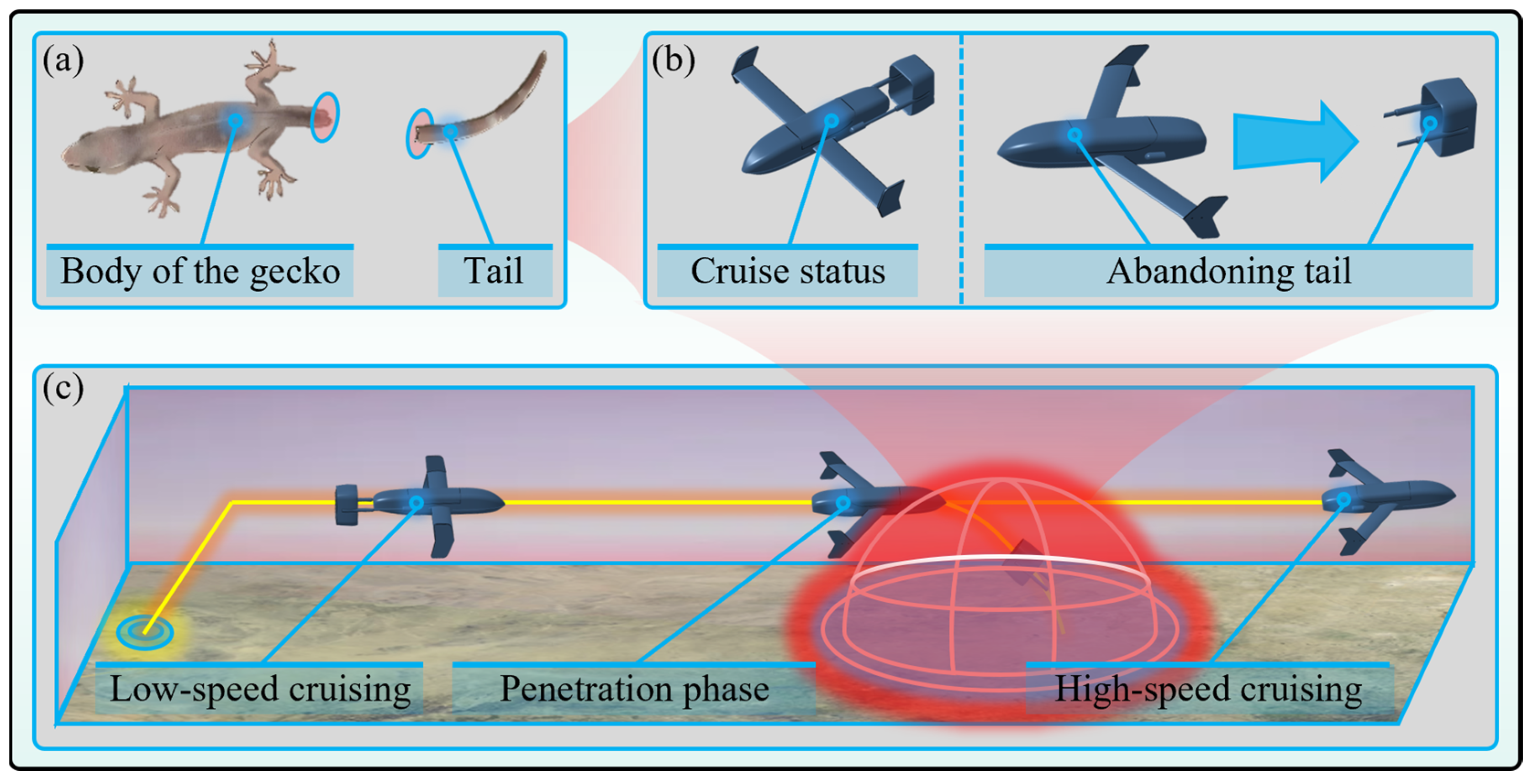

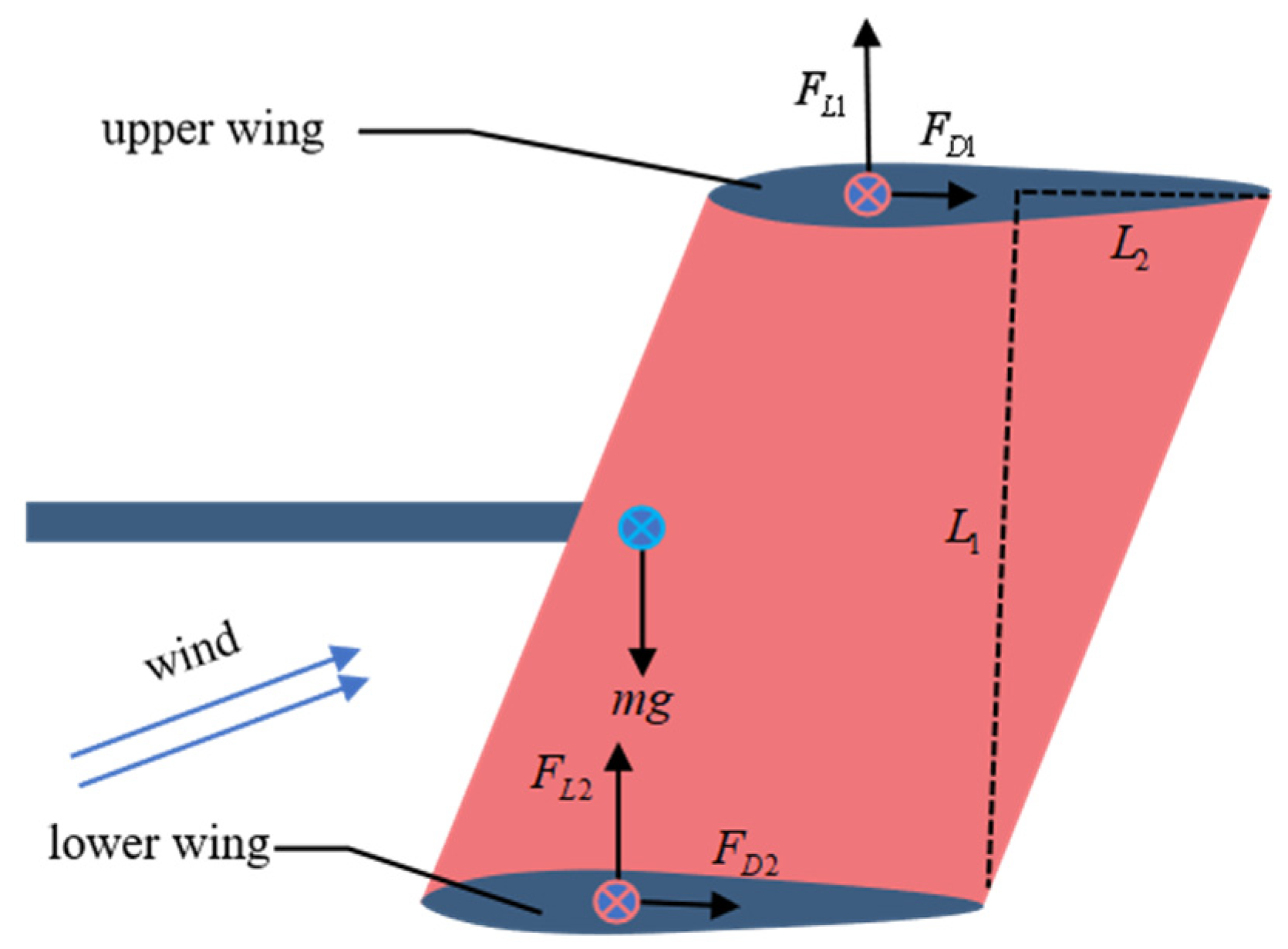
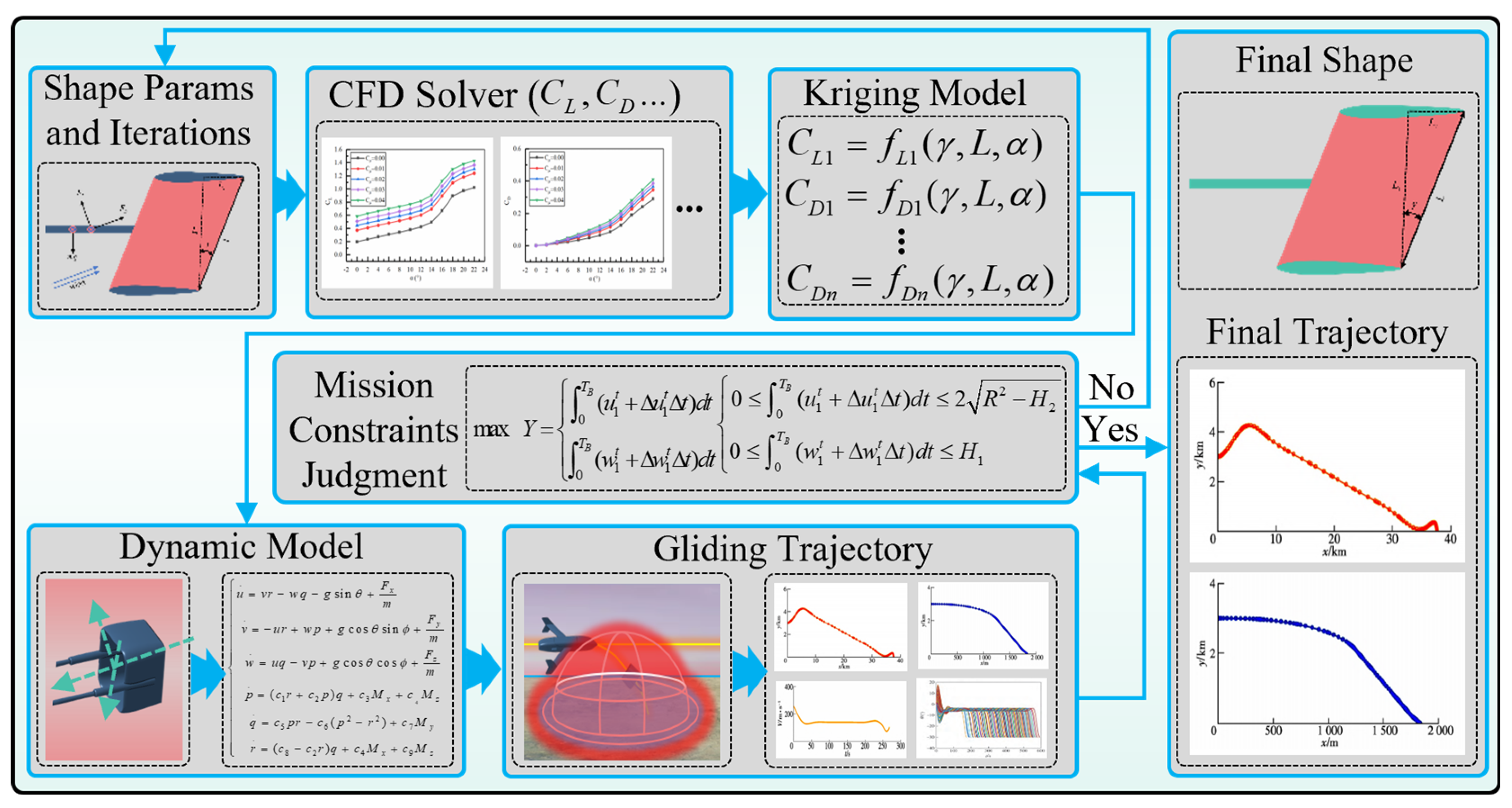


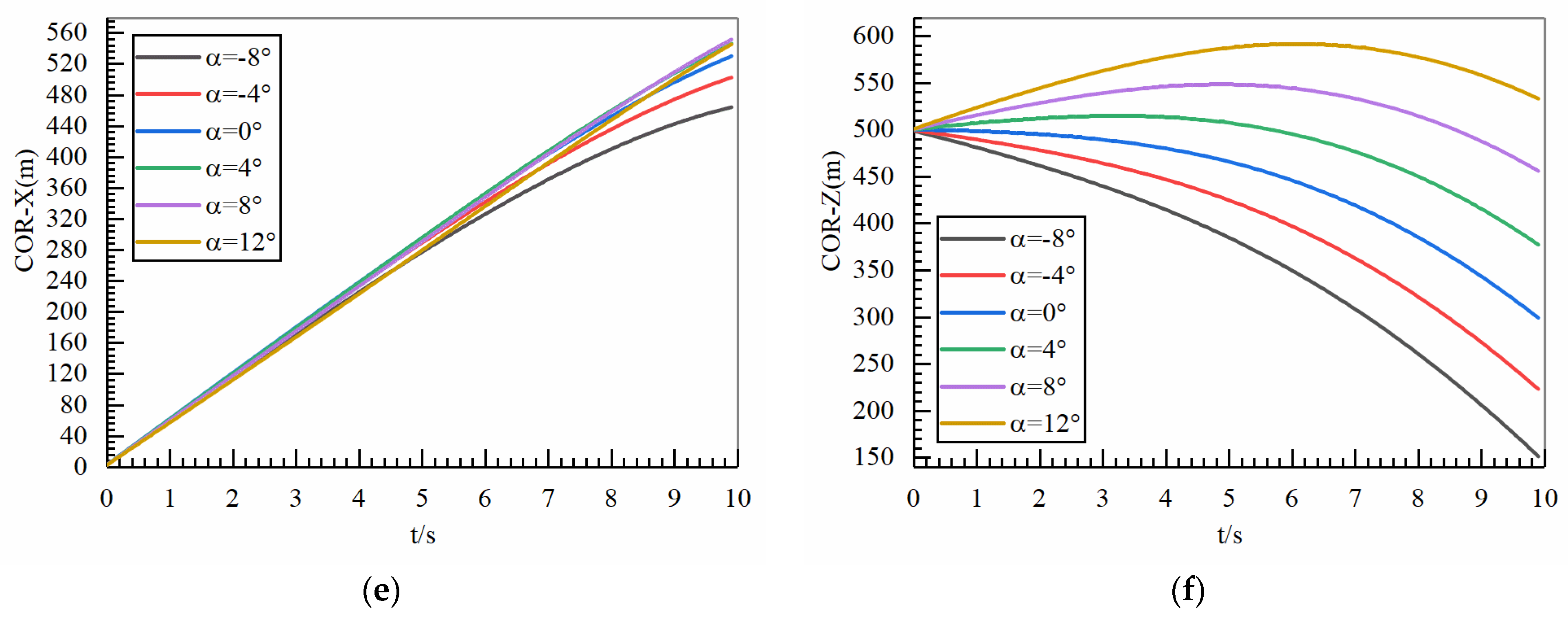

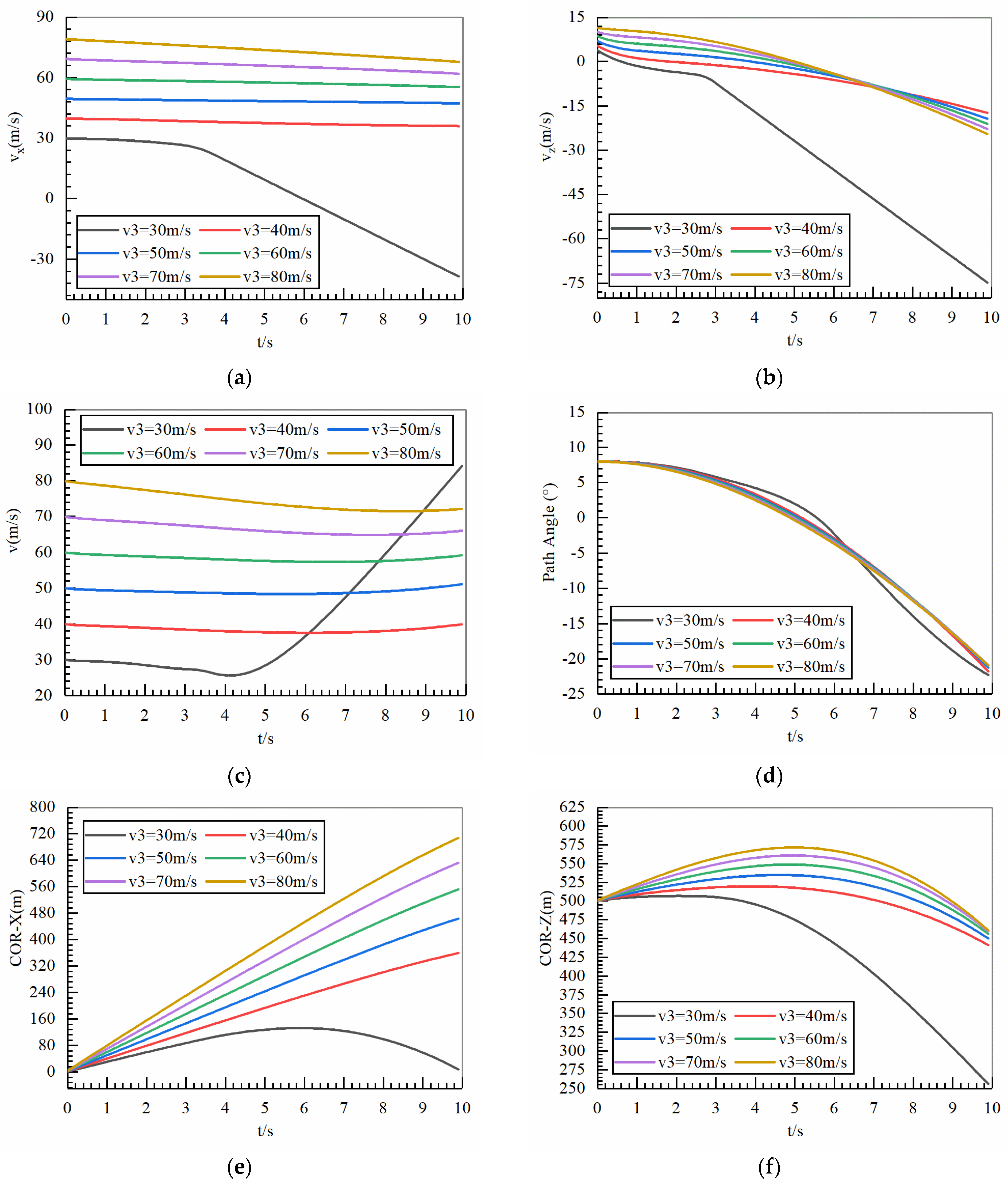
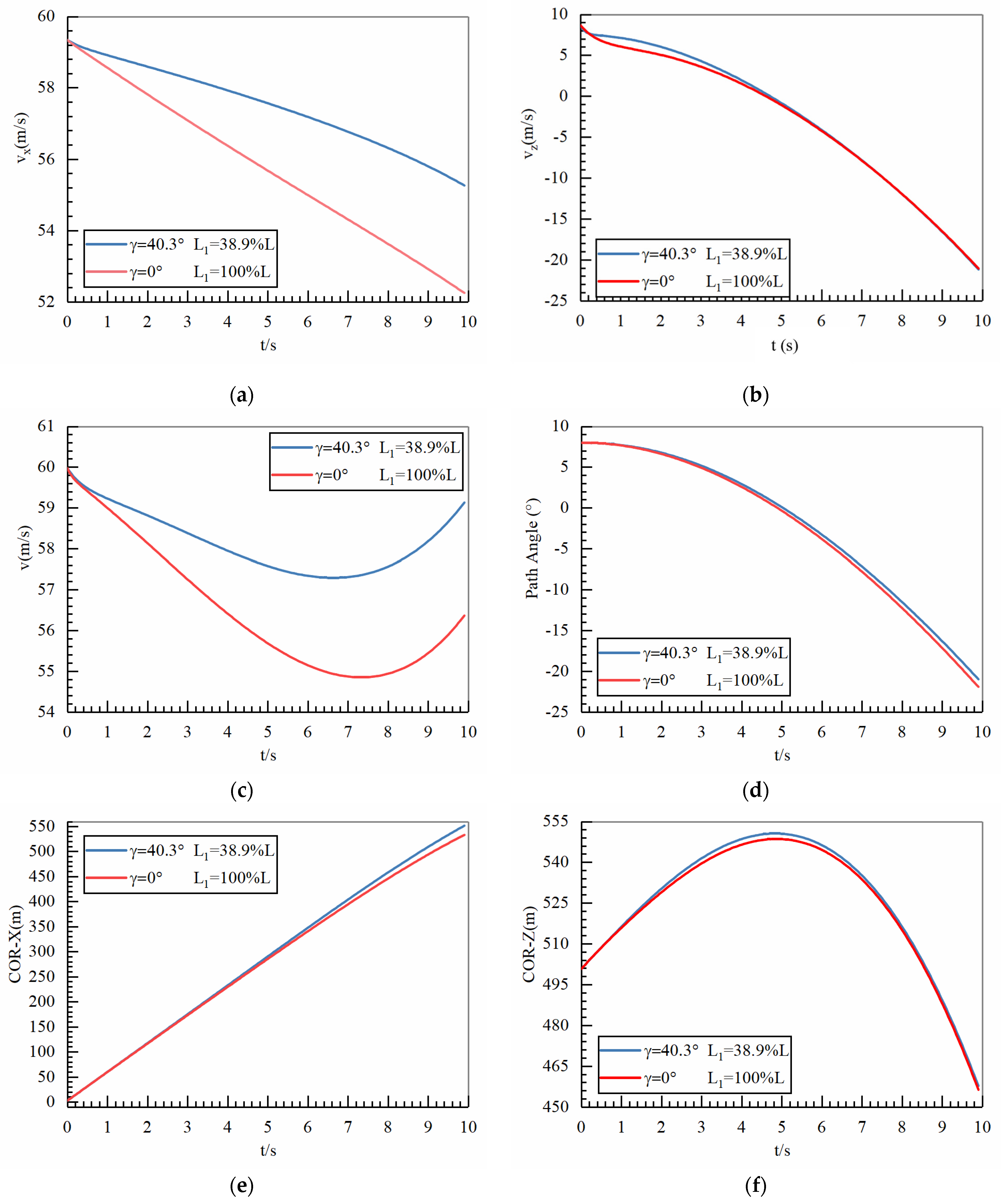
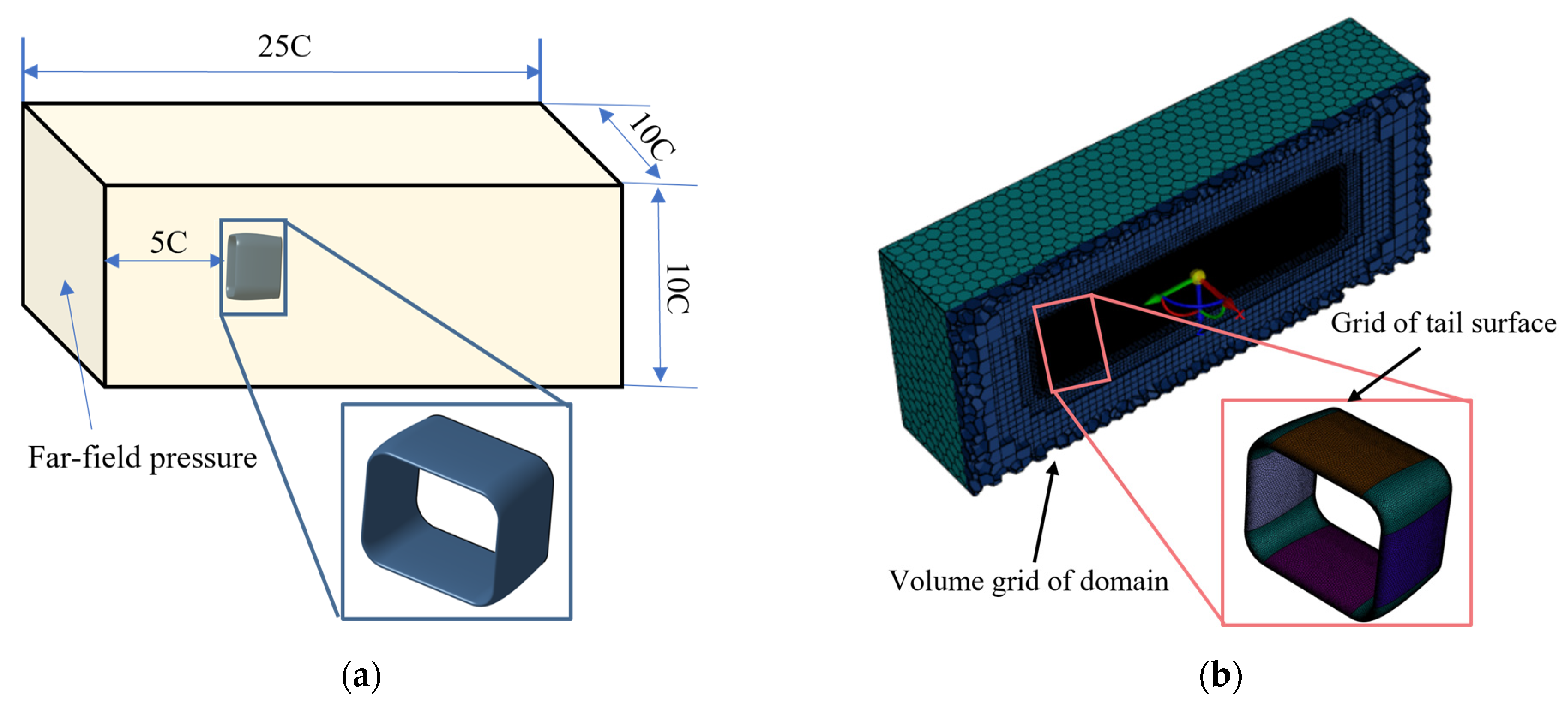
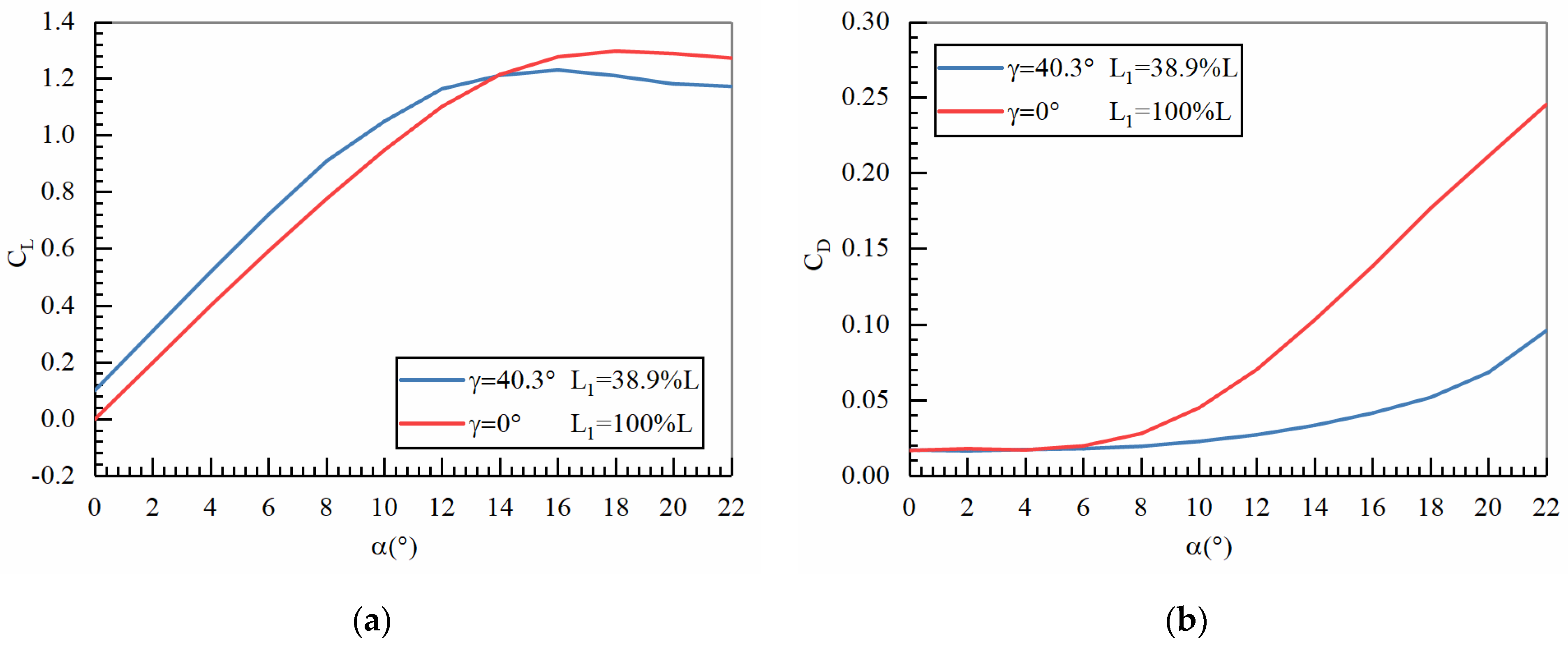
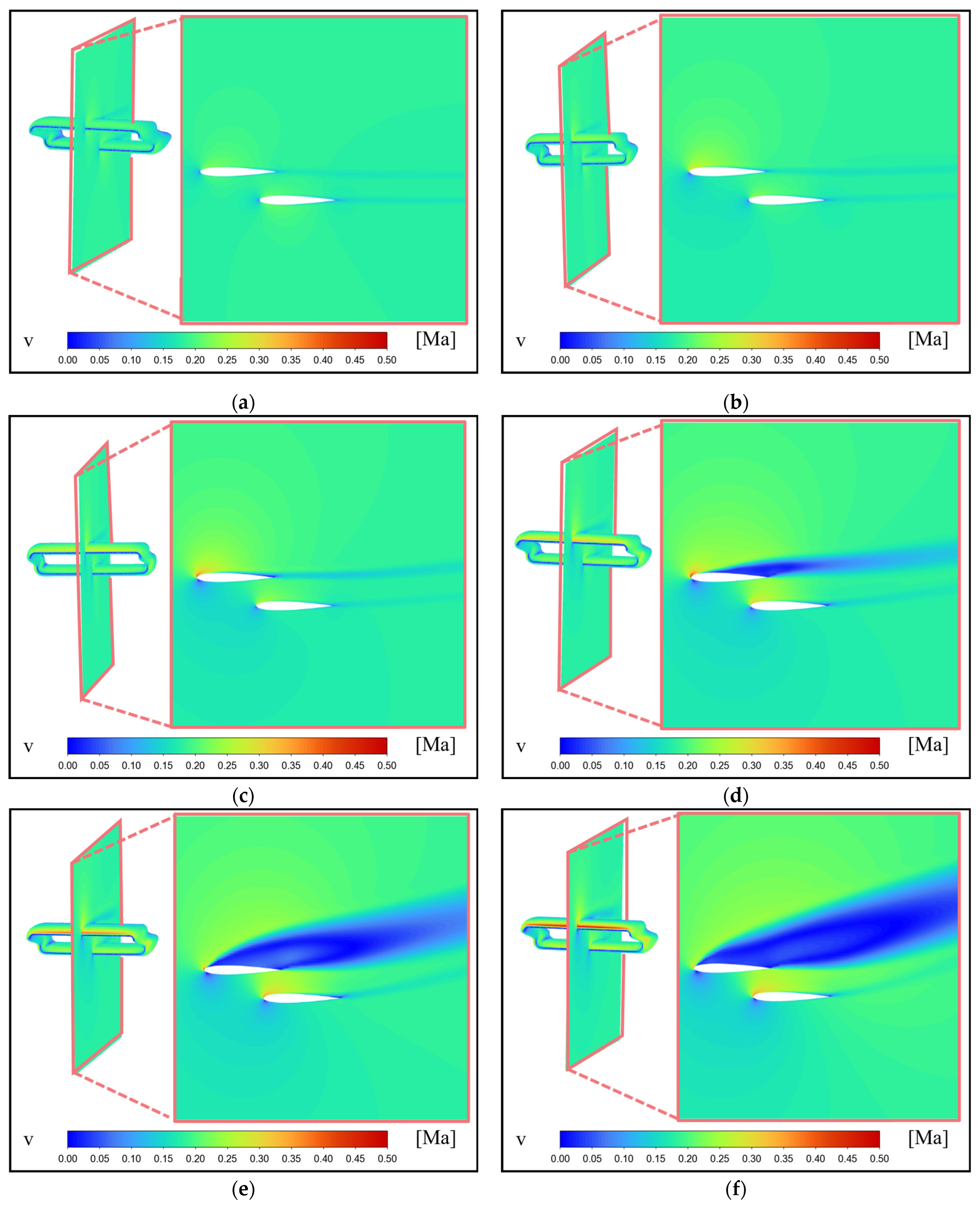
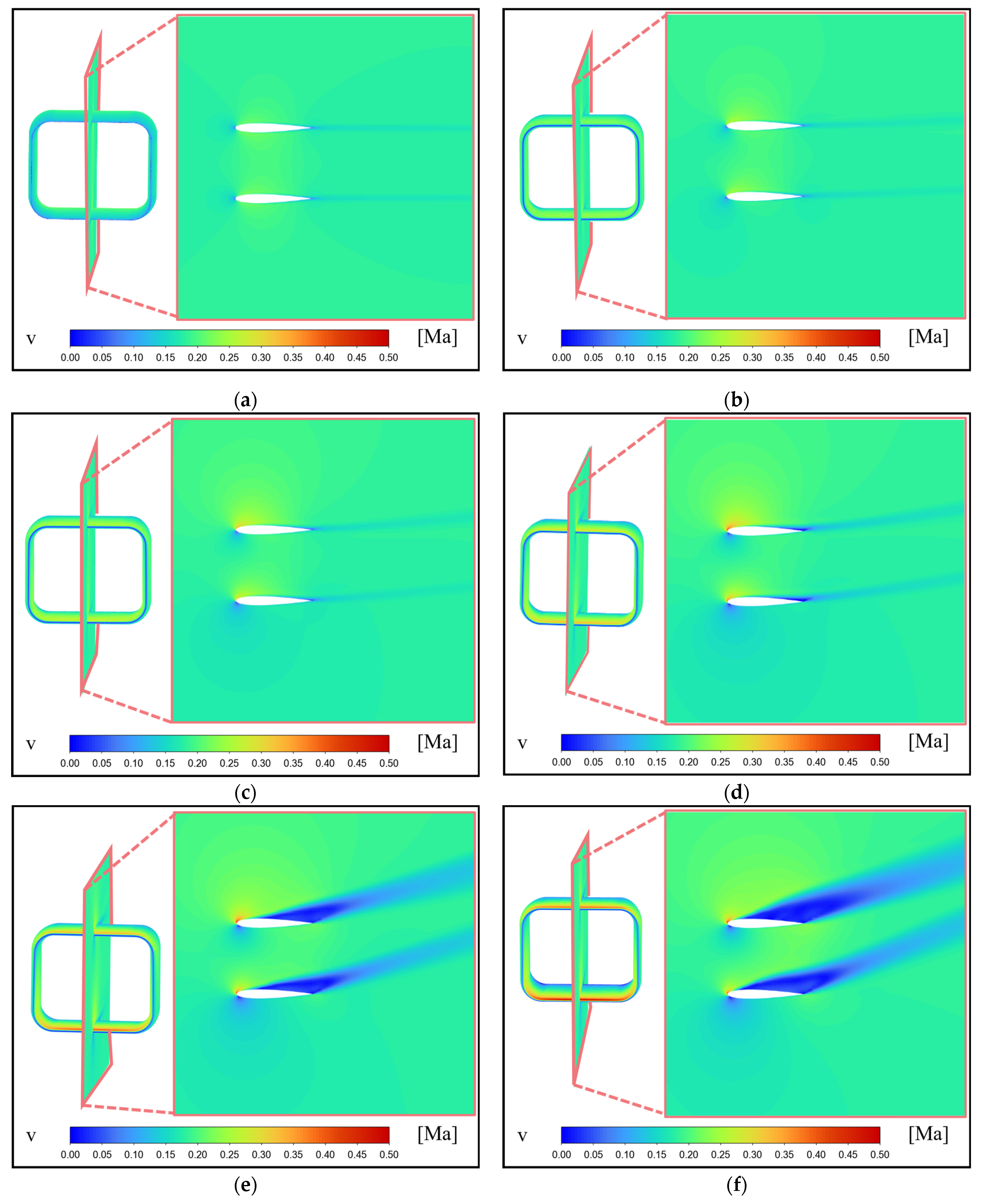
| Symbol | Parameter | Value | Unit |
|---|---|---|---|
| Velocity in X-axis direction | _ | m/s | |
| Velocity in Z-axis direction | _ | m/s | |
| Angular velocity in Y-axis direction | _ | rad/s | |
| Pitch angle | _ | ° | |
| Resultant force in X-axis direction | _ | N | |
| Resultant force in Z-axis direction | _ | N | |
| Resultant moment in Y-axis direction | _ | N.m | |
| Distance in X-axis direction | _ | m | |
| Distance in Z-axis direction | _ | m | |
| Y-axis moment of inertia | _ | kg·m2 | |
| Tail weight | 1 | g | |
| Gravitational acceleration | 9.8 | m/s2 |
| Overall Shape | Symbol | Parameter | Value | Unit |
|---|---|---|---|---|
 | Airfoil | Airfoils of upper and lower wings | NACA0012 | _ |
| Chord length | 200 | mm | ||
| Vertical distance | mm | |||
| Horizontal distance | mm |
| Overall Shape | Symbol | Parameter | Value | Unit |
|---|---|---|---|---|
 | Airfoil | Airfoils of upper and lower wings | NACA0012 | _ |
| Chord length | 200 | mm | ||
| Vertical distance | mm | |||
| Horizontal distance | mm |
| Parameters | Number of Coarse Meshes | Number of Medium Meshes | Number of Refined Meshes |
|---|---|---|---|
| Number of meshes | 756,000 | 1,687,000 | 3,175,000 |
| Lift coefficient of tail | 0.7732 | 0.7596 | 0.7519 |
| Drag coefficient of tail | 0.0397 | 0.0384 | 0.0372 |
Disclaimer/Publisher’s Note: The statements, opinions and data contained in all publications are solely those of the individual author(s) and contributor(s) and not of MDPI and/or the editor(s). MDPI and/or the editor(s) disclaim responsibility for any injury to people or property resulting from any ideas, methods, instructions or products referred to in the content. |
© 2025 by the authors. Licensee MDPI, Basel, Switzerland. This article is an open access article distributed under the terms and conditions of the Creative Commons Attribution (CC BY) license (https://creativecommons.org/licenses/by/4.0/).
Share and Cite
Jia, H.; Zheng, H.; Huo, S.; Zhou, H. Dynamics Simulation and Optimization of Gliding Tail Decoy. Aerospace 2025, 12, 212. https://doi.org/10.3390/aerospace12030212
Jia H, Zheng H, Huo S, Zhou H. Dynamics Simulation and Optimization of Gliding Tail Decoy. Aerospace. 2025; 12(3):212. https://doi.org/10.3390/aerospace12030212
Chicago/Turabian StyleJia, Huayu, Huilong Zheng, Shunbo Huo, and Hong Zhou. 2025. "Dynamics Simulation and Optimization of Gliding Tail Decoy" Aerospace 12, no. 3: 212. https://doi.org/10.3390/aerospace12030212
APA StyleJia, H., Zheng, H., Huo, S., & Zhou, H. (2025). Dynamics Simulation and Optimization of Gliding Tail Decoy. Aerospace, 12(3), 212. https://doi.org/10.3390/aerospace12030212






